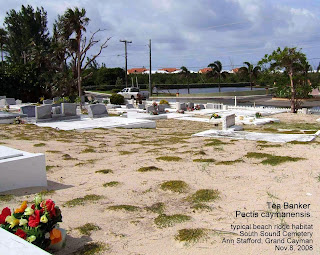Ironwood Chionanthus caymanensis Stearn, Bot. Notiser 132:58 (1979)
OLEACEAE Olive Family
Cayman
Islands endemic, Endangered tree
FLORA of the CAYMAN ISLANDS by George R. Proctor, 2012, published by Kew p.595, Fig.221, Pl.58
Wild Trees in the Cayman Islands BY Fred Burton, illustrated by Penny Clifford, 2007, p.144/220
FLORA of the CAYMAN ISLANDS by George R. Proctor, 2012, published by Kew p.595, Fig.221, Pl.58
Wild Trees in the Cayman Islands BY Fred Burton, illustrated by Penny Clifford, 2007, p.144/220
Threatened Plants of the Cayman
Islands The Red List by Frederic J. Burton, 2008, p.49
There
are many plants around the world with the common name ‘Ironwood’, but Chionanthus caymanensis, the tree called
Ironwood in the Cayman Islands is endemic – it grows only on Grand Cayman, Little Cayman and Cayman Brac and nowhere else in the
world, in rocky woodlands, close to a fresh water table.
Grand Cayman Nature Tours
Cayman Islands Ironwood grows to 10 m tall.
Ironwood tree and Banana Orchid (Myrmecophila thomsoniana var. thomsoniana),
two Cayman endemics.
two Cayman endemics.
Photo: Ann Stafford, Lower Valley forest, Jan.13, 2002
Grand Cayman Nature Tours
Cayman Islands Ironwood grows to 10 m tall.
Ironwood tree with Old George (Hohenbergia caymanensis), a giant Bromeliad,
growing in its branches, in a George Town garden. Both are Cayman endemics.
growing in its branches, in a George Town garden. Both are Cayman endemics.
Photo: Ann Stafford, Aug. 23, 2002.
Cayman Islands ENDEMICS pictures
Plants and creatures
The leaves are arranged in exactly OPPOSITE pairs.
Photo: Ann Stafford, Grand Cayman, Nov. 13,2006.
The flowers are small, fragrant and white in many-flowered panicles.
Ironwood in bloom in a George Town garden.
Photo: Ann Stafford, May 1, 2011.
Many-flowered panicle.
Photo: Ann Stafford, George Town garden, Grand Cayman, May 1, 2011.
Ironwood flowers and leaves from a George Town garden.
Cayman’s Ironwood is a culturally significant tree.
Cousin Cora's Cottage, Boggy Sand Road, West Bay.
The original one room wattle-and
The original one room wattle-and
Photo: Lorna McCubbin, 1998
Cousin Cora's Cottage, made of wattle and daub with ironwood posts,
Boggy Sand Road, West Bay.
Photo: Lorna McCubbin, 1998
Cousin Cora's Cottage showing wattle and daub interior with ironwood posts,
Boggy Sand Road, West Bay.
Photo: Lorna McCubbin, 1998
The heavy wood is very hard, strong, termite and water-rot resistant, not inclined to warp. It was traditionally used for the foundation posts of houses.
Lorna McCubbin in her wattle-and-daub house,Cousin Cora's Cottage
Photo: Ann Stafford, Boggy Sand Road, West Bay, Jan.19, 2003
Ironwood post base.
Photo: Ann Stafford,Jan.19, 2003
Cayman CULTURAL pictures
Step-wells, traditional buildings, games, arts and crafts, house-shaped grave markers, ships, Cayman catboats, monuments, maps, stamps, Hell and more.
A young Ironwood tree was planted in George Town.
Photo: Ann Stafford, Feb.22, 2004
Ironwood - living fence post, Grand Cayman.
Photo: Ann Stafford, July 31, 2006
Ironwood - Chionanthus caymanensis is the predominant tree in the Ironwood Forest,
George Town, Grand Cayman.
University College of the Cayman Islands hall has white roof (mid-right).
Photo: Lois Blumenthal, June 2007.
Ironwood - Chionanthus caymanensis, Endangered endemic,
is the predominant tree in the Ironwood Forest.
Old George - Hohenbergia caymanensis,
a Critically Endangered Grand Cayman endemic giant Bromeliad,
grows on the pinnacle rock and up in the trees.
Photo: Ann Stafford, Sept.11, 2005.
Ironwood with Resurrection Fern - Polypodium polypodioides growing on the trunk.
Photo: Ann Stafford, Oct.9, 2005
Ironwood - Chionanthus caymanensis, Endangered endemic,
is the predominant tree in the Ironwood Forest.
Old George - Hohenbergia caymanensis,
a Critically Endangered Grand Cayman endemic giant Bromeliad,
grows on the pinnacle rock and up in the trees.
Photo: Ann Stafford, Sept.11, 2005.
Ironwood with Resurrection Fern - Polypodium polypodioides growing on the trunk.
Photo: Ann Stafford, Oct.9, 2005
Pictures of Cayman Islands plants
Endangered Ironwood with other native trees in a George Town garden,
Mahogany - Swietenia mahagoni Endangered, Spanish Elm - Cordia gerascanthus Endangered, Broadleaf - Cordia sebestena var. caymanensis Vulnerable, Popnut - Thespesia populnea Endangered, Silver Thatch - Coccothrinax proctorii Endangered, Bull Hoof - Bauhinia divaricata and Burn Nose - Daphnopsis americana Critically Endangered.
Mahogany - Swietenia mahagoni Endangered, Spanish Elm - Cordia gerascanthus Endangered, Broadleaf - Cordia sebestena var. caymanensis Vulnerable, Popnut - Thespesia populnea Endangered, Silver Thatch - Coccothrinax proctorii Endangered, Bull Hoof - Bauhinia divaricata and Burn Nose - Daphnopsis americana Critically Endangered.
Silver Thatch - Coccothrinax proctorii and Ironwood,
2 Cayman endemics, Colliers Wilderness Road.


























